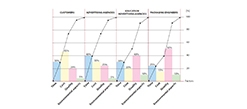Paper and Paperboard
The difference between fine paper and paperboard - Development of an assisting tool for material decision
Summary
The difference between fine paper and paperboard may at a first glance appear trivial. Unfortunately, if the properties of each material are not accurately defined and understood valuable resources, such as material, time and cost, can be wasted. Hence, this project, performed in collaboration with Iggesund Paperboard AB, aims to spread knowledge about the difference between fine paper and paperboard, and create an awareness about how to make, and the importance of, a conscious material decision for fine paper and paperboard applications, among operators in the graphical and packaging industry.
A conscious material decision implies a decision that is based on holistic knowledge about the fine paper and paperboard application development process, including the properties of fine paper and paperboard. During such a decision, important factors (e.g. durability, run-ability, and environmental impact) that contribute to an optimal material for a specific application, and the comprehensive consequences of applying the material, are taken into account. Thereby, this decision results in an understanding of how to use minimum resources and gain maximum quality when developing a fine paper or paperboard application.
The chosen approach is to identify the current material decision procedure, and which factors and desired properties that are, and should be, considered for fine paper or paperboard applications in order to optimize the application throughout the development. This has been performed by conducting several theoretical and empirical studies, where the investigated operators are found in the graphical and packaging industry. Although, the primary focus during this project has been directed towards the operators within advertising agencies, as they are the weakest link in terms of lacking knowledge about the investigated manner. Also, they are the ones interacting with the entire graphical and packaging chain, including the customers of fine paper and paperboard applications. Thereby, the knowledge to perform a conscious material decision, throughout the graphical and packaging chain, could be provided by the transfer of knowledge from the operators within advertising agencies.
The goal is to optimize the material decision procedure by providing needed knowledge, to enable a conscious material decision, in a product. This product is supposed to serve as assistance for the primary users, i.e. operators within advertising agencies, when deciding material for fine paper and paperboard applications. In doing so, the operator will obtain enough knowledge to make conscious material decisions. Thereby, reduced time, cost and environmental impact can be obtained, together with an increased quality of the produced application.
The development process, of a product concept that provides a solution to the current lack of knowledge, resulted in a book that serves as an assisting tool for (primarily) operators within advertising agencies during material decision for fine paper and paperboard applications. Further, the tool acts as a link between the operators within advertising agencies, and the already existing information, i.e. fills the gap of knowledge in-between these two knowledge holders. This is performed by the assisting tool through the included fundamental knowledge about the fine paper and paperboard application development process, and the fostering of planning and communication.
Skriv ut ![]()


